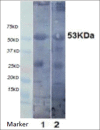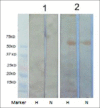A 53 KDa Glycan Antigen of Hydatid Cyst Wall May Involve in Evasion from Host Immune System
- PMID: 29930922
- PMCID: PMC5991282
- DOI: 10.4103/abr.abr_287_16
A 53 KDa Glycan Antigen of Hydatid Cyst Wall May Involve in Evasion from Host Immune System
Abstract
Background: Recent studies have shown that similar host glycan antigens are expressed by helminths such as Echinococcus granulosus hydatid cysts to evade from host immune system. In this work to investigate these antigens further, immunological cross-reactivity between human sera and hydatid cyst wall antigens has been investigated.
Materials and methods: Hydatid cyst wall antigens were used in enzyme-linked immunosorbent assay and Western immunoblotting and probed with pooled sera of hydatidosis patients and healthy controls. Sodium metaperiodate treatment was used to investigate glycan antigens.
Results: A band with molecular weight about 53 KDa reacted with both hydatid patients' sera and also normal human sera. It has been shown that this band was a glycan antigen.
Conclusions: A 53 KDa glycan antigen of hydatid cyst wall that reacted with all human sera may have an important role for evasion from host immune system.
Keywords: Antigen; glycan; hydatid cyst; immune evasion.
Conflict of interest statement
There are no conflicts of interest.
Figures


Similar articles
-
Antibody response to glycan antigens of hydatid cyst fluid, laminated layer and protoscolex of Echinococcus granulosus.Med J Islam Repub Iran. 2017 Feb 11;31:12. doi: 10.18869/mjiri.31.12. eCollection 2017. Med J Islam Repub Iran. 2017. PMID: 28955662 Free PMC article.
-
Immunological diagnosis of human hydatid cyst using Western immunoblotting technique.J Res Med Sci. 2016 Dec 26;21:130. doi: 10.4103/1735-1995.196612. eCollection 2016. J Res Med Sci. 2016. PMID: 28331516 Free PMC article.
-
Immunological detection of human and camel cystic echinococcosis using different antigens of hydatid cyst fluid, protoscoleces, and germinal layers.Vet World. 2021 Jan;14(1):270-275. doi: 10.14202/vetworld.2021.270-275. Epub 2021 Jan 29. Vet World. 2021. PMID: 33642814 Free PMC article.
-
Immunodiagnosis of sheep infections with Echinococcus granulosus: in 35 years where have we come?Parasite Immunol. 2014 Mar;36(3):125-30. doi: 10.1111/pim.12072. Parasite Immunol. 2014. PMID: 24033483 Review.
-
Control of host complement activation by the Echinococcus granulosus hydatid cyst.Immunopharmacology. 1999 May;42(1-3):91-8. doi: 10.1016/s0162-3109(99)00023-5. Immunopharmacology. 1999. PMID: 10408370 Review.
Cited by
-
Parasite-enhanced immunotherapy: transforming the "cold" tumors to "hot" battlefields.Cell Commun Signal. 2024 Sep 26;22(1):448. doi: 10.1186/s12964-024-01822-4. Cell Commun Signal. 2024. PMID: 39327550 Free PMC article. Review.
-
Immunization with Hydatid Cyst Wall Antigens Can Inhibit Breast Cancer through Changes in Serum Levels of Th1/Th2 Cytokines.Int J Prev Med. 2020 Dec 11;11:189. doi: 10.4103/ijpvm.IJPVM_311_19. eCollection 2020. Int J Prev Med. 2020. PMID: 33815713 Free PMC article.
References
LinkOut - more resources
Full Text Sources
Other Literature Sources

